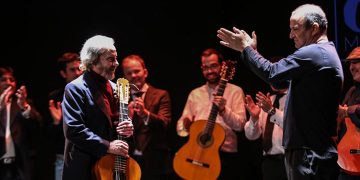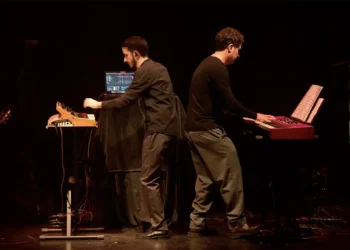Interview: Pablo San Nicasio Ramos
Photos: Rafael Manjavacas
«Now more than ever, we need young flamenco artists»
|
At the rate we’re going, the traditional families of flamenco are going to have to be preserved under lock and key like rare wine with official designation status, without mixtures. We wouldn’t want them to disappear. Elements which are inseparable from the culture of a people and their art. Because if flamenco is truly a World Cultural Heritage, it’s due to, among other things, the tender loving care with which some dynasties have passed from generation to generation knowledge which has begun to yield profits. And within the oral tradition of flamenco, the house of Sordera is one of the most important. We chatted with Vicente Soto (Jerez, 1954) about his new recording, “Colores Distintos”.
That’s right, the record was a long time coming out. But since I was feeling at home in Jerez, and spending more time there than before, I decided to do something there. I listened to the young people, Luis Carrasco, Sorderita, José de Gabriela…they gave me the strength to do this. Some could even be children of mine, they’re so young. But I needed a fresh approach, and the record came out like them, fresh and new. They give you ideas, they produce the record and participate. The guitarists are also from the new generation, they’re fantastic. My daughter sings a little…it’s a way of introducing them into the learning process, little by little. Like you say, for the last few years I’ve been involved in other projects, but not all of them were meant to be. The economic situation left a lot of things by the wayside. Like the documentary “Cantaor”, or the 8-part series for Spanish Television we were working on. Yes, it’s done, but resources are scarce and there’s nothing to do but wait. It seems like a return to Jerez, because despite everything, you hadn’t been focused on your hometown. I’ve always had an open mind and been willing to get involved in the projects that you might call “external”, but my thing, my roots, have always been Jerez, and I never abandoned that. For this recording it occurred to me, everything is right there. You don’t have to get on the phone to make appointments for people to come and record…there, we all see each other because we’re neighbors and we get it all together in no time. There weren’t thinking about flamenco, but the literary quality… We’re talking about Cervantes, Quevedo, Pessoa, Góngora…and flamenco has the music to provide adequate wrapping. I don’t mean to run down popular flamenco verses that reveal a lifetime in two lines, created by people who couldn’t read or write. But with the literary poets I learned a lot. Did it take a long time to make “Colores Distintos”? Yes and no. We started two or three years ago, but we’ve done it very little by little, in our own good time. Those young people you mention, what do they think about? Internet has opened a lot of doors for them. They have everything going for them, the mindset, the resources to have access to the art…perhaps what’s missing is opportunities. Because the ones who really know and make a difference, always remember the old singers and want to know about them. They’re made for flamenco, but there’s not much cash around right now. And now, more than ever, we need them, because the maestros are dying off and we need to renew the ranks. It would be no exaggeration to say that right now in Jerez there are between thirty and forty young people with possibilities. “There’s a piece of Fernando Terremoto’s. He didn’t do it on his record and just think, I was with him years ago and he wrote me those things without even thinking. Before anything was wrong with him, I already had that, but he didn’t even have time to hear me do it”. That sounds like a lot. No, and I’m only talking about the Santiago neighborhood! So just imagine in the whole city. Two or three children per family, with the cousins, nieces and nephews…they’re people who right now are ready to come up, and they have wonderful flamenco ability. We don’t see you so much around Madrid. I was in Madrid for years, and now just occasionally. Like I say, I’m mostly in Jerez. Back in the days of Los Canasteros, where I began as a guitarist with Manzanita, all the flamenco artists were in the capital, and this went on until the mid-eighties more or less. Then I started going to Jerez frequently, and these days it doesn’t matter that much where you live. I live on the Calle Nueva in Jerez, the same house where I was born. I did some work on it, and that’s where I intend to stay. I don’t know if you’re aware there’s a bar in Jerez called “La Crisis” (the economic recession). We’re just a bunch of wise-guys. Today’s problems, and now I’m talking seriously, are worse, because we’ve gone from the good to the bad. We all knew the good times and were used to living well. In my day we just had a ball and threw it around. There were no luxuries, nor did we even know they existed. But young people now are forced to give things up, and it’s hard for them. You’ve gone back to Jerez, and there are references to some people on the record. Yes, for example there’s a piece of Fernando Terremoto’s. He didn’t do it on his record and just think, I was with him years ago and he wrote me those things without even thinking. Before anything was wrong with him, I already had that, but he didn’t even have time to hear me do it. And now it’s out. I love it. He was a real artist. Jerez lost a lot when he went, and also with Morao, who left us in the blink of an eye. I already had my record half-finished…I’ve got things in my head to dedicate to him in the future. “There’s such a variety of bulerías, people would be amazed. For example, bulerías of Lebrija have a more forceful compás that those of Jerez, which are swift and light. And that comes out in the cantes, some more laidback than others. It’s not really the same at all”.
Five bulerías on the record. Yes, but each one in a different style. There’s one which is like a waltz, another more typical of Jerez, another of Lebrija…they’re not the same. There’s such a variety of bulerías, people would be amazed. For example, bulerías of Lebrija have a more forceful compás than those of Jerez, which are swift and light. And that comes out in the cantes, some more laidback than others. It’s not really the same at all, and the person telling you this sang in the Fiesta de la Bulería at the age of 13, in the first one ever held. It was celebrated on the terrace of El Tempul. That was 45 years ago. Agujetas senior sang, Terremoto, Tío Borrico…the poster still exists. What’s different about these “colores” you’re bringing us now? Colors of the marshes, of earth, of freshness. For example, in the siguiriya that gives the record its name, I took some things from my predecessors Paco la Luz and Anica la Periñaca, and I brought them into my own zone. From the position of utmost respect I feel for them, I put my own mark, my different color. It’s about remembering and renewing. Like in the soleá where I do my own version of the soleá of Tio Juanichi… We were talking about Paco la Luz…your family goes way back… Absolutely, and with no classes or anything. I started singing and playing guitar when I was little, and even danced a bit. I was with Manolo Sanlúcar, Enrique de Melchor…I didn’t need to attend any school, it was the school of life, sharing life with people like that gives you so much, it puts you in circulation very quickly. There’s a line of thought that underlines the fact that the Jerez school is limited, that you don’t do all cantes equally well. There’s some truth in that. And it doesn’t matter. There’s an identity that comes from the singer families, and which makes you more inclined towards some styles than others. It’s not a bad thing, because the rest of the cantes are also strong and we like them. But needless to say, bulerías, soleá por bulerías, siguiriya, martinete…all that has a certain something in Jerez that makes them special. I don’t know, it must be in the land, like the air of Cádiz…
|




 You were six years without recording, but with other projects in the works, several at once.in fact.
You were six years without recording, but with other projects in the works, several at once.in fact.






















